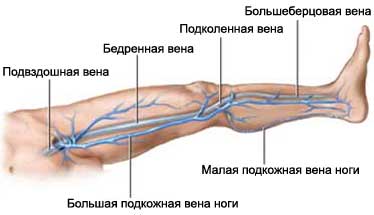Venography – Venogram
Description venography
Venography – X-ray examination, used to study the veins. Leg venography is used to study the veins in the legs after the introduction into the bloodstream of a radiopaque substance.

Causes of venography
- Diagnosis of deep vein thrombosis – blood clots deep in the leg, which may lead to vascular obstruction in the lung (pulmonary embolism);
- Search blockage in the veins;
- Assessment of inherent problems with veins;
- Evaluation of the functioning of the valves of deep veins of the lower extremities;
- Search veins, to be used for bypass.
Possible complications venography
Some possible complications:
- Infection;
- Tissue damage;
- Phlebitis – inflammation of the veins;
- Allergic reaction to the contrast dye;
- Renal;
- The formation of blood clots;
Patients with kidney disease or diabetes mellitus, especially those, who take metformin (Glyukofazh), have a higher risk of developing complications from venography.
How is venography?
Preparation for the procedure
You may be asked not to eat anything and only drink clear fluids for four hours before the test. Tell your doctor, if you have allergies, hay fever or a bad reaction to contrast injection. If you are nervous about the test, your doctor may give you a sedative.
It is necessary to organize the return home from the hospital after a venography.
Procedure venography
You will lie on the x-ray table leaning. Area catheter insertion (pipe for injection of contrast agent) cleared, and a catheter inserted into a vein. Also for ease of administration to the skin can be made small incision. You can provide a local anesthetic, to numb the catheter insertion site.
The catheter is inserted into a vein (usually a vein in the leg), after which it was slowly fed contrast agent. The ankle can be tightly bound up, or the lower part of the body can be tilted. It helps quickly fill the veins contrast agent. Then the doctor with the help of X-ray unit is studying the movement of the contrast in the veins.
After venography
The catheter is removed, at the injection site will bandage.
- After returning home, you need to have a rest before the end of the day and try to avoid any physical exertion;
- Drink plenty of fluids over the next 24 hours, to bring the contrast agent from the organism;
- You can remove the bandage the day after the test;
- Note discomfort at the injection site, any swelling, fever, redness, pain, or isolation. The pain of the injection can last for several days;
- If the site of injection or puncture occurs bleeding or swelling, you need to put pressure on the incision, at least 10 minutes.
Ask the doctor, when it is safe to shower, bathe, or expose the catheter site to water. Most people can return to daily activities the day after the test.
How long will venography?
The test takes about 30 minutes. The time may be more than, depending on the specific test.
Will it hurt when venography?
You may feel some pain at the injection site during the test, and the pain for several days thereafter. Some people report mild discomfort throughout the body, the presence of nausea, during the contrast injection into the veins.
Results venography
A positive result means venography, that the blood flow through the vein is normal. Detection of abnormalities when venography means, that there is a blockage of blood flow through the vein. Based on the results the doctor will make a decision on further examination or treatment.
Contact your doctor after venography
After testing, you need to see a doctor, If the following symptoms:
- Fever or chills;
- Swelling, redness or pain at the injection site;
- Itch, rash or other signs of allergic reaction.
